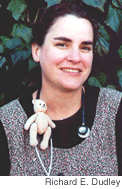
|
December 8, 2000
|
|
A Cough and Cold Primer
![]() his
time of year I wish I had a magic wand. With one wave I could stop hundreds
of runny noses and nagging coughs. But I'm a pediatrician, not a magician,
and sadly there's no cure for the common cold. Researchers are busy developing
nifty antiviral medications to reduce flu symptoms, but until then, we're
stuck taking it one mucus-filled day at a time.
his
time of year I wish I had a magic wand. With one wave I could stop hundreds
of runny noses and nagging coughs. But I'm a pediatrician, not a magician,
and sadly there's no cure for the common cold. Researchers are busy developing
nifty antiviral medications to reduce flu symptoms, but until then, we're
stuck taking it one mucus-filled day at a time.

|
|
And for parents, that's quite a task. Normal, healthy kids can get six to 12 viral infections each year. Since most of the infections strike between September and March, you can easily expect to deal with one illness a month. This is not what most us bargained for when we signed up to be parents.
Colds and influenza (the flu) are caused by viruses, and they are spread by that magical secretion: mucus. Your sick child sneezes into a tissue and continues playing with his action figure. Then your toddler wanders by, grabs the toy, puts it in her mouth, and in a few days you've got another runny nose to keep up with.
When it comes to colds and the flu, the best offense is a good defense. I push hand washing because it's the most effective way to prevent infections. Breast feed babies, avoid tobacco smoke, and get a yearly flu shot for everyone over 6 months of age. Keep your hands away from your eyes, nose, and mouth, because this is where viruses get their foothold. Scrutinize your child's daycare or school: Are there plenty of sinks, paper towels, tissues, and wastebaskets?
Once the virus has made your house its home, offer your child plenty of liquids -- water, popsicles, jello, and juice. Conventional wisdom holds that dairy products thicken mucus, but there is no evidence to support this claim. Dairy, particularly milk, is an important source of nutrition for children and therefore shouldn't be categorically avoided. There is no scientific evidence that vaporizers or humidifiers ease symptoms, but some parents and pediatricians believe that they do. If your child's fever is making her miserable, give her acetaminophen (Tylenol) or ibuprofen (Motrin or Advil).
Since no one has the magic wand, parents often go in search of the magic pill or liquid. Cold and cough medicines don't cure anything; they are meant to relieve some of your child's symptoms. And there is no scientific evidence that cold medicines help children under 6 years old. Most products contain similar active ingredients, so if the one you have isn't doing the trick, it's unlikely that a different brand will work any better.
Decongestant medications like pseudoephedrine hydrochloride and phenylpropanolamine (PPA) may help dry up runny noses, but they can also cause an accelerated heart rate and nightmares. After recent reports of an increased risk of stroke in young women, the FDA issued an advisory about PPA and is in the process of banning it. Antihistamines like diphenhydramine, chlorpheniramine, and brompheniramine -- which work against allergic triggers that can make the nose run and the eyes itch -- are also included in cough and cold preparations. Sometimes they help, and sometimes they cause sedation or even irritability. You may want to save these for bedtime use.
|
When your child wakes up four times a night, it's hard to remember that a cough is a good thing. It keeps mucus from accumulating in the chest, which could cause a more serious infection. Cough medicines suppress this protective mechanism; most cough and cold medicines contain dextromethorphan (DM) for this purpose. The other ingredient you'll see is an expectorant called guaifenesin, but this hasn't been proven useful by most research.
Combination cold medicines, which treat a laundry list of symptoms, often contain pain- and fever-reducing medicines like acetaminophen and ibuprofen. Be careful not to give your child a separate dose of acetaminophen or ibuprofen if your combination product already contains it. Make sure you have the right dropper or measuring device, and use your child's weight to select the proper dose. When in doubt, check with your pediatrician or pharmacist.
Remember, colds and the flu are caused by viruses, not bacteria. Antibiotics have no effect on viruses. They do kill bacteria, but their overuse has led to increasingly nasty bacteria that are resistant to all antibiotics. Some children with colds and the flu develop bacterial ear infections or pneumonia, and antibiotics may be appropriate for these children. If your child is sick and has unusual symptoms -- a strange rash, headache, difficulty breathing, or wheezing -- check with your pediatrician.
And finally, as the winter season progresses and holidays, family visits, and vacations approach, remember that kids will get sick and there's a good chance you might too. Set reasonable expectations, make flexible plans, and keep your sense of humor as we all wait for that magic wand.
Related links:
-
Rx.magazine feature story: Echinacea: A Natural Solution
-
Rx.magazine feature story: Flu Shots for Whom?
-
Rx.magazine feature story: Danger in the Medicine Cabinet? FDA Warns About Stroke Risk from PPA
-
Rx.magazine feature story: Frivolous Use of Antibiotics Can Be Dangerous
Send feedback on this article.
Lisa M. Asta, M.D., F.A.A.P., is a board-certified pediatrician and a fellow of the American Academy of Pediatrics. Dr. Asta graduated from Johns Hopkins University and Temple University School of Medicine. She trained at St. Christopher's Hospital for Children in Philadelphia, Pennsylvania. She is an assistant clinical professor of pediatrics at the University of California San Francisco School of Medicine. She practices in Walnut Creek, California.










